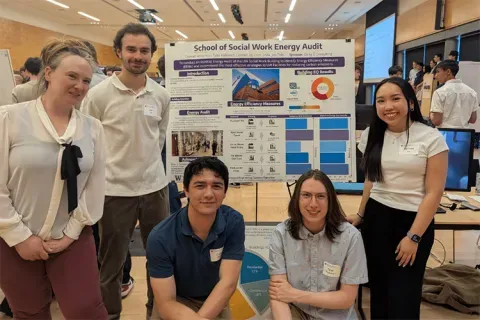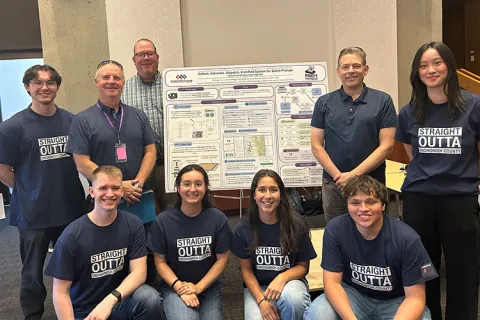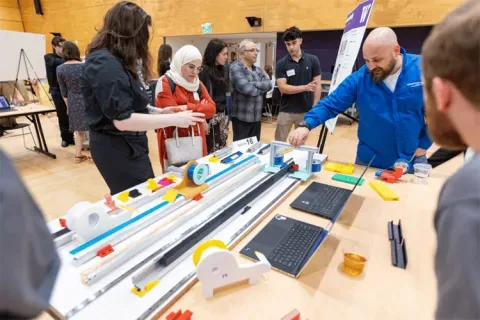Industry-Sponsored Student Capstone Projects
2022/2023
In the 2022/23 academic year the industry capstone program was supported by 56 sponsors and 99 real-world projects. Nearly five hundred and fifty students from across the College of Engineering participated. Scroll down to learn more about each project.
NASA Jet Propulsion Laboratory
Machine Learning for Extreme Traverse Lunar Explorer
This student team worked to apply machine learning algorithms to Lidar data and images taken during the operation of a subterranean robot in extreme environments on Earth and the Moon. The robot utilizes autonomy to operate an extreme traverse architecture (snake-like robot). The near-term application is sub-glacial environments on Earth, and real-world field data of experiments with the snake-like (EELS) robots can be provided. A desired outcome this student team worked towards was the demonstration of a machine learning algorithm to autonomously identify and potentially characterize hazards in Lidar image data taken from the field experiments of the EELS robot. These experiments would be performed in ice crevasse and other glacial-like environments. As a stretch goal, the student team could work to integrate other perception sensor data on the exterior/skin (i.e. torque sensing, temperature data) of the EELS snake robot into the ML algorithms based on Lidar imaging.

NASA Jet Propulsion Laboratory
Machine Learning for Lunar Multi-Static Ground Penetrating Radar
The project sought to apply machine learning algorithms to multi-static radar images taken from a network of autonomously cooperating robots. The student team worked to develop such algorithms to be used on real-world data obtained from the multi-static GPRs operating on NASA’s CADRE Technology Demonstration on the moon, schedule for launch 2024. GPR data is essential for in-situ resource utilization discovery and characterization, and sub-surface science more generally. These resources include water ice, materials that can be used in propellant or power generation. A network of GPRs can generate significant data volumes in short periods of time that must conventionally be analyzed by “humans-in-the-loop” approaches, these can take from hours to days or more. In addition data oberved under the surface may be useful in guiding or controlling the mobile GPR platforms (robots) to new physical locations, this may occur in very short time-scales (seconds to minutes). Combining these factors along with the limited communications bandwidth from the moon (or other planetary body) to Earth, provides strong motivation to autonomously and intelligently analyze and characterize the raw multi-static GPR data to arrive at useful information. Machine learning algorithms offer significant potential in this regard. A desired outcome was the demonstration of a machine learning algorithm to autonomously identify and potentially characterize significant identifiers or discriminators in model data, real-world data from controlled field experiments, and finally real-world data obtained from the surface of the moon.

NASA Jet Propulsion Laboratory
Machine Learning for Smart Space-Based Radiation and X-Ray Spectrometer Instruments
This student team worked to apply machine learning algorithms to the space-based operation and calibration of two small instruments that are planned to fly on a CubeSat mission in the 2024 timeframe. The instruments generate time-series data streams at the output based on physical properties measured at their respective inputs. The challenge this student team worked to address is to convert these time series data streams into useful information that is: 1) reliably reproduceable and related to actual physical properties being measured, and 2) to calibrate the information such that error is either known or bounds can be placed on the information. The student team was able to work to utilize the dynamic environment, both the physical parameters being measured and the environment the sensor operates in (e.g., space environmental factor such as temperature) as models to more accurately use the raw data to infer actual physical property being measured. Machine Learning is a technique that has been used successfully in these type of application in the past, and this student team was encouraged to explore the use for these two sensors. A desired outcome this student team worked to accomplish was to demonstrate machine learning algorithms to autonomously calibrate time-series outputs from two instrument, radiation sensor and x-ray spectrometer, based on the space environment the sensors will operate in. In other words, software that will convert raw data streams from the instruments into useful calibrated information.
National Oceanic and Atmospheric Administration (NOAA)
Intertidal Sensor Array for Monitoring Ocean Change Stressors in Oyster Farms
This student team worked with a team of researchers at the NOAA Northwest Fisheries Science Center (NWFSC), the University of Washington School of Aquatic and Fisheries Science (SAFS), and Baywater Shellfish to develop a robust intertidal sensor array that can be deployed by shellfish growers to measure water quality parameters related to ocean change. The student team attempted to expand on capstone work from 2021/22 and work to produce data that can be used by growers to identify appropriate management strategies. The key parameters were temperature, pH, oxygen, salinity, and chlorophyll. To accomplish this, the student team worked to combine commercially available sensors with newly designed components that integrate data management, power supply, and wireless communication in a physically robust package that is intended to function in a harsh environment. The student team attempted to produce a functioning sensor array that they will field test in local shellfish farms. If successful, the array would provide reliable data at the target precision. The student team was also expected to write documentation of sensor design and operation, including deployment and maintenance S.O.P.s and sensor analysis software user manual.
National Security Innovation Network (NSIN)
Electronically Steerable Ultra-Wideband Antenna
The National Security Innovation Network (NSIN) is a network in the U.S. Department of Defense (DOD), aimed at connecting DOD entities with academic and venture partners to innovate new solutions for DOD-member challenges. This student team worked to create an ultra-wideband electronically steerable flat panel antenna capable of tracking and communicating with satellites out to Geosynchronous Orbits. Desired Frequency Range is ~400 MHz to ~11GHz Goals and objectives this student team worked to meet included: • Support maximum flexibility and use of software defined radios • Antenna that requires no assembly or mechanical steering to track objects in flight including satellites on orbit • Low cost solutions are preferable • Antenna must fit on top of a standard 20 ft shipping container
National Security Innovation Network (NSIN)
Navy Requirements Markup Language
The National Security Innovation Network (NSIN) is a network in the U.S. Department of Defense (DOD), aimed at connecting DOD entities with academic and venture partners to innovate new solutions for DOD-member challenges. Navy specifications and requirements are usually presented in a narrative long form (e.g., paragraph), see example below. Common requirements types are: Build Specifications; MILSPECs; CONOPS, and Industry Standards. Example Narrative Requirement: “Each educator shall be selected based on an actuating fluid of seawater at 20°C and available firemain actuating pressure, a suction lift equal to X.X m (YY feet) of water, the capability to discharge its rated capacity against a head equivalent to the height of its overboard discharge plus the resultant dynamic losses, and a service fluid containing solids up to ZZ mm in diameter. The nozzle tip and the throat of the discharge shall be such that the flow of fluid at the capacities listed in Table I will not produce erosion of the parts under service operating conditions.” The Challenge: These narrative requirements are hard to parse visually, and nearly impossible parse using machines in any effective timeframe. Machine readable requirements are a major enabler for digital engineering transformation efforts. This student team worked to achieve the following solutions: 1. Develop standardized navy requirement markup tags extending the schema.org standard tags. 2. Convert various requirement document types utilizing extended markup language. 3. Develop AIML natural language processing to scale up conversion of requirement documents to machine readable documents
National Security Innovation Network (NSIN)
Optimize PME Cooling
The National Security Innovation Network (NSIN) is a network in the U.S. Department of Defense (DOD), aimed at connecting DOD entities with academic and venture partners to innovate new solutions for DOD-member challenges. Primary Mission Equipment (PME) is largely comprised of air-cooled, Commercial-Off-The-Shelf (COTS) components, which are typically not ruggedized to military specifications (MILSPEC) and therefore have lower temperature limits and typically require more cooling than MILSPEC PME. However, due to frequent tech-refresh-driven PME upgrades and the complexity of various facilities’ cooling systems, it is common practice to overcool the PME. This is generally a result of [1] poorly defined temperature requirements for the PME (e.g., weakest components drive the cooling requirement for the entire PME container/rack even though a slight overtemp will only result in a reduction of warrantied service life, which often greatly exceeds the actual tech-refresh schedule, and not a loss in system performance); [2] non-optimal PME rack designs (e.g., the most rugged components, typically power supplies, are not cooled last, rather than saving the colder in-line cooling air for the weaker components); and [3] poorly controlled or non- optimized facility cooling systems. For the purpose of the NSIN problem statement, this student team will work to focus on [1] and/or [2]. For [1], this student team worked to review typical mission COTS PME and using a combination of literature, analysis, and test, quantify a relationship between temperature requirements, (reduced) service life, and performance; the student team also worked to include a recommendation for reducing cooling costs while maintaining performance, based on the service-life findings in relation to typical PME refresh cycles. For [2], the student team then attempted to analytically show the energy savings relationship between an “optimal” PME rack design (i.e., in-line cooling position based on temperature specifications) and a non-optimal design. For completeness, the student team aimed to show the relationship in [2], including the findings from [1]. [1] Northeastern University Program Director, National Security Innovation Network (NSIN), U.S. Department of Defense, 508.925.0337, jgriffin@nsin.us, http://www.nsin.mil/
National Security Innovation Network (NSIN)
Optimize Radome Heating
NSIN is a network in the U.S. Department of Defense (DOD), aimed at connecting DOD entities with academic and venture partners to innovate new solutions for DOD-member challenges. New Boston Space Force Station's (NBSFS) radomes are heated with fuel oil in the winter, expensive and an ever-increasing risk to resiliency, particularly considering current events in eastern Europe. Two of NBSFS' radomes are also de-humidified to, presumably, prevent interior condensation. There is no specific Primary Mission Equipment (PME) temperature requirement driving the radome interior temperature, as all the PME is located in an equipment room inside the radomes, which is controlled separately from the radome interiors. This student team worked to reduce the wintertime temperature set point in the NBSFS radomes from 45°F to 35°F, which would save ~10% of the annual fuel oil requirement. This student team also sought to prevent interior condensation freezing as well as help diminish external snow build up. Ideally, this student team worked to create or identify one point on the interior of the radome which could be used to regulate the requisite temperature, and thereby save fuel oil and reduce the NBSFS carbon footprint; the “smart point” could be measured/monitored, e.g., with infrared, and the regulation logic would be modeled as a function of outside air temperature, interior humidity, weather, sunshine, snow accumulation, etc. Tasks the student team worked to accomplish included: [1] review the literature, conduct analyses and modeling, to establish a notional “smart point”, if possible [2]develop the logic for controlling the radome interior temperature to achieve the objective of minimizing fuel oil for heating while maintaining the required radome mission performance.
National Security Innovation Network (NSIN)
Wireless Embedded Sensor Monitoring
The National Security Innovation Network (NSIN) is a network in the U.S. Department of Defense (DOD), aimed at connecting DOD entities with academic and venture partners to innovate new solutions for DOD-member challenges. There are many off the shelf type sensors such as accelerometers, pressure transducers, flow, current, voltage and temperature sensors that operate in certain ranges and frequencies rates to output data. These sensors need to be installed at specific locations on the equipment or unit under test that requires many of them to be installed without obstructing the equipment operation. Wired sensors are a bit challenging to manage because of all the wires necessary to feed into a data acquisition system. Wireless sensors eliminate the challenges with wires but wireless must be secure enough to meet stringent cyber security requirements and be resilient enough to prevent attack or break down from usage. The form factor of the sensor would be embedded in equipment such that it is secure and rugged and can withstand the rigors of the environmental and operational conditions and not impede or interfere with equipment or process of operation. The wireless radio should be able to reach up to 200 feet from the equipment to the point of reception of the data and be of low power so that the battery can operate up to 10 years. The sensor(s) would be triggered when there is an event that occurs to activate the sensing quickly in less than 1ms. The sensor should be reasonably priced compared to similar sensors and readily available in the market place. This student team worked to build a small sensor that can fit into equipment form factor, be non-intrusive, and send out accelerometer/vibration data out at least at a 10KHz rate. This student team also worked to identify an interface that allows a wireless radio to be paired to a sensor and test the data rates that the sensor and radio can reliably perform and identify if the bandwidth of the radio is sufficient to handle the data needs of the application to collect all the data.
Novo Nordisk
Application for Early Alzheimer's Disease Diagnosis
Detecting the onset of early-stage Alzheimer’s Disease, along with monitoring the progression of the disease, is well-known to be difficult and, often-times, unreliable. Simply put, there has yet to be a clinically validated tool or methodology for determining the biomarkers that indicate the presence and progression of Alzheimer’s disease. This student team worked to develop a digital tool that can integrate inputs from well-established, in-home, and wearable devices as data which, through an AI and ML programmatic approach, aims to synthesize that data, providing a reading which can indicate both the presence of Alzheimer’s Disease and the degree of change of that disease over time. Two key factors which are baseline and that the student team worked to incorporate into the tool were inputs which capture the patient's gate (wearable) and sleep patterns (wearable and/or smartphone). The student team sought to include other data inputs incrementally as project timing/cost/complexity allows. These included some or all of the following: speech patterns, eye tracking, reading tracking, device patterns (typing and gestures), home movement patterns. The essential concept here is that more inputs equal more data to integrate and provide a more focused and complete picture of the patient's condition. Outcomes this student team worked toward include: • Working prototype, end-user platform/tool • Solution accessible from tablet or smartphone • Name and branding for tool • Mapping and progressive design outputs (e.g. journey map, app map, flowchart, thumbnails, design comps, etc.) • Software which displays the appropriately modified information and diagnostic recommendations (personalized to their capability/level of ability) in a usable (accessible - UX standards) visual format (easy to use dashboard and navigation). • Demonstrated successful real world use/testing - patients can easily access the application with the follow-on understanding of the appropriate information/course of action through the interface
Novo Nordisk
Data Insights Application for Financial Implications of Chronic Disease
Financial implications often impact those suffering from a chronic disease. Improving the patient experience and outcomes in the chronic disease space is an ongoing critical need, and this student team worked to focus on the financial impact on those suffering with sickle cell disease. Patients with sickle cell disease experience significant lifetime costs associated with obtaining and receiving adequate medical care. This student team worked towards the development of a data model that captures and analyzes patient-level cost information to drive informed decision making. Anticipated outcomes this student team worked toward include: • Working prototype, end-user platform for our sickle cell cost tool • Solution is accessible from desktop, tablet, and smartphone • Name and branding for tool • Reporting/visualization output designs
Novo Nordisk
Data Insights Application for Obesity
Comorbidity risk is an ever-present concern for patients with obesity. This student team worked to create a data insight application that provides a quantitative view into the comorbidity risk present in a patient with obesity through the modification of weight, social determinants of health (SDoH), and associated risk factors. The data model built aimed to support the application utilizes clinical, commercial, and SDoH data to understand the correlations between obesity, related comorbidities, and SDoH. The vision for the application was to provide internal Novo Nordisk (NNI) stakeholders quantitative insights into risks faced by patients to better educate clinicians about the risks and costs associated with obesity. This student team worked towards defining, designing, and developing the application for the obesity tool. Anticipated outcomes this student team worked toward include: • Working prototype, end-user platform for our obesity tool • Solution is accessible from desktop, tablet, and smartphone • Name and branding for tool • Reporting/visualization output designs
Novo Nordisk
Digital Companion for Chronic Disease Patient
It is estimated that 1/3 of people diagnosed with a serious, life-changing chronic illness or disease will experience symptoms of depression such as loneliness, sadness, isolation, and despair. As chronic conditions such as Type II Diabetes and Alzheimer’s Disease increase, the condition of depression rises commensurately. Compounding the circumstance, many people who suffer from chronic illness and depression remain isolated or homebound. Finding a solution in-home to alleviate depression can help these people achieve more positive health outcomes. This student team worked to develop a digital companion device (digital robot/pet, standstill device, Tamagotchi-like device, etc.) which would provide information and direction for helping this patient manage their condition (dietary, physical activity, medication management, emotional support, etc.) but more importantly, provide the patient with personified feedback that is customized to their unique needs as well as employing ML/AI to both learn (train) and remember. These were meant to be in the form of command -based and proactive interaction. The student team worked to build a robot that would ideally employ multiple output modalities such as voice, on-screen text and visuals, LED’s, movements, and sound effects, to create a more extensive and dynamic experience for the patient. The robot could also employ a personality (similar to chatbots) as well, creating a personal/customized connection with the patient. Anticipated outcomes this student team worked towards included: • Working prototype, end-user platform • Solution is accessible from smartphone or wearable • Name (personality) of tool • Drawings, schematics, plans for tool elements beyond physical prototype
Novo Nordisk
Medication Management for Alzheimer's Disease Patient
In most cases of Alzheimer’s Disease, the average age of diagnosis is between the ages of 55 to 64 years. Given this average age of diagnosis, and the length of time which the disease progresses, many of these Alzheimer’s patients have also been diagnosed with other co-morbid conditions, such as type 2 diabetes, cardiovascular disease, gastrointestinal disease, and depression. Managing the medications for some, or in some cases all of these conditions, is notoriously complex and difficult for both the patient and the caregiver. Medication contraindications often occur, and the patient will need to deny one medication in order to take one that is deemed more critical. Further complications often arise, given the cognitive impairment of the patient, which places more stress on the caregiver to negotiate the polypharmacy demand and avoid adverse events for the patient. This student team worked to develop a tool/device and/or process which can alleviate the complexity of this circumstance for the Alzheimer’s patient in particular, but could also be utilized for other complex medical conditions. This tool attempted to utilize the unique medical circumstance of the user (patient) and be able to communicate a plan for the patient to manage their medications through distinct direction and/or dispensing, or both. This may be a stand-alone device (dispense medications) or a smartphone application which guides/manages the patient, and may be designed to accommodate the degree of Alzheimer's (mild, moderate, severe impairment). Anticipated outcomes this student team worked toward include: • Working prototype, potential hardware/device, end-user platform/application • Solution is accessible from smartphone, wearable or as standalone device • Drawings, schematics, plans for tool elements beyond physical prototype

PACCAR
Automation of Dash Tester Connections
This student team worked to create an automated solution capable of accurately and repeatedly connecting and disconnecting a plate containing multiple cable connectors to the connectors on the rear of an assembled dash to be tested at the production plants. This automation could potentially be used in a plant, along with all of the information (plans, source code, diagrams, et cetera) required for the Manufacturing Support Team to build more and was intended to free up test operators to be able to use their time more efficiently and reduce the amount of time required to test each dash. The intention was to save time and money for the plant and the company as a whole. This was the final part of a larger effort to automate the testing process and will be extremely valuable to the Manufacturing Support Team and the manufacturing plants themselves.
Related News

Mon, 10/13/2025 | UW Mechanical Engineering
Capstone collaboration leads to award
An ME capstone team received first place for its energy audit of the UW School of Social Work building.

Thu, 07/17/2025
UW engineering students develop smart ballot solution
UW engineering students develop smart technology solution to improve ballot collection for Snohomish County.

Mon, 07/07/2025 | UW Mechanical Engineering
Capstone creations
Students displayed innovative capstone design projects at the 2025 expo.

Fri, 09/20/2024 | UW Civil & Environmental Engineering
Smarter irrigation for a greener UW
A new project combines satellite data with ground sensors to conserve water and create a more sustainable campus environment.